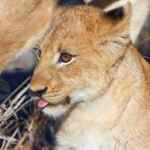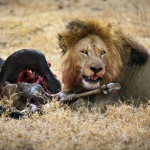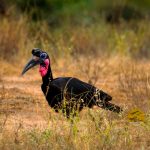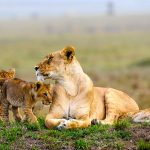10 Interesting Facts About the African Buffalo: A Wild Survivor of the Savanna.
Facts About African Buffalo; The African buffalo, also known as the Cape buffalo, is a large bovid and one of the most dangerous animals in Africa; it also forms part of the “Big Five”-a term that denotes a group of animals considered to be the most difficult and dangerous ones to hunt in the continent; But beyond this intimidating presence, the African buffalo displays some complex social behaviors, singularly distinctive physical structure, and an astonishing survival strategy in the wild. Now let’s take a closer look at ten of the most interesting facts about this marvelous animal.
1. The Cape Buffalo: Built for Africa’s Diverse Terrain
They do not occur just anywhere; from savannas to woodlands and to river valleys, the African buffaloes roam many ecosystems across sub-Saharan Africa. While they are adaptable, they thrive best where there is access to water sources since they have to drink daily. This explains how they can navigate the dry seasons in such a way that they may cover great distances in search of water and fresh grazing lands, hence being resilient in usually harsh landscapes across Africa.
2. Nature Force: Size and Physical Strength
Large, muscular, extremely powerful, these are the African buffaloes. Males, known as bulls, usually weigh between 700 and 1,200 kg (1,500-2,600 pounds) and can be as tall as 1.7 meters high at the shoulder. Females are much smaller but no less hardy. With such massive build and a muscular body frame, African buffaloes turn out to be one of the most problematic animals for predators to overpower.
3. The Boss: Their Unique Horn Structure
They are easily recognized by their iconic horns, which curve outward then inward to meet in that hard base, a “boss.” This is particularly large in males and acts almost as a shield against their skull when they participate in battles for dominance; The boss is thick and nearly helmet-like; this is extremely useful in combat where the bulls clash over a mate or territory. Females are also horned, but the horns are narrower and without the thick boss found in males.
4. Memory and a Keen Instinct for Survival
The African buffalo possesses very exceptional memory and instinct for survival. They have been observed to remember the hotspots of predators, especially specific individuals like lions, in case they have had any assault from them and managed to escape; Such memory indeed instills them with an instinct of advanced survival strategies-like the defensive group against attackers and the locomotion of the herd so as not to stop in some vulnerable spot.
5. Herd Life: Complex Social Structures and Roles
The living of African buffaloes is social; they do it in herds that differ in size. Such large herds are organized around family groups that are led by females, whereas males are constantly moving in and out according to age and status; Sometimes older, larger males cannot keep up with the pace of a regular herd and may break off into smaller bachelor groups known as “dagga boys,” living closer to water courses.
In the large herd, there is a distinct hierarchy, with a matriarchal figure leading it. When predators are located, buffaloes naturally reposition themselves in a natural instinct to protect the weaker ones among them, like calves, by putting them right at the center of a circle. This enclosed social unit gives protection to all and power in numbers.

6. Means of Communication and Alarm Calls
Communication among buffaloes includes both vocalizations and body postures. A low grunt can signal the herd to start moving; louder grunts and snorts alert other members to possible danger. If buffaloes are threatened by a predator, they would automatically call to each other, after which the herd would bunch together for defense; The bonds of the herd are such that a member is always within earshot so that in case a predator approaches, the herd would be ready to remobilize in defense of its members.
7. Mud Baths for Protection and Comfort
The wallowing of the African buffaloes in mud forms several basic needs. The mud cools the body temperature naturally during hot days in the savanna. It assists them also in preventing many insects from landing on their skin and repels the insects like tsetse flies and ticks; In most areas, buffaloes are seen contesting for major wallowing spots near waterholes especially in the hottest times of the year.
8. Grazing Habits and Digestive Adaptations
African buffaloes are essentially grazers, taking grasses as the major constituent of food. Unlike some herbivores that rely on quality grass, buffaloes have digestive adaptations for tougher, low-quality grasses that other more selective grazers can hardly survive on. During the dry season, these animals take on shrubs and bushes, making them among the most versatile African herbivores. The four-chambered stomachs and powerful digestive system enable them to break down foods containing fiber and, therefore, resist seasonal changes in the availability of food.
9. Fierce Herd Defenders
African buffaloes are brave and stubborn, especially when defending their herd. It adopts a group defense when threatened by circling the calves or those that are sick, positioning the stronger buffaloes on the outside; Particular, bulls are accustomed to frequently attacking predators that put their group in danger; even lions are no exception and could be attacked upon to keep the lion forces at bay. This collective bravery of the herd makes them a hard nut to crack even for the advanced predators of Africa. Remarkably, buffaloes have been reported to attack lions that attacked their herd members earlier, utilizing their memory and group loyalty.
10. Part of the African Ecosystem
Besides being strong survivors, African buffaloes play a crucial role in maintaining ecological balance. By feeding on grasses, they prevent overgrowth and allow more species of plants to thrive. They fertilize the soil with their dung to the benefit of several plants and insects, and their pathways through dense vegetation offer avenues for most animals across communities. African buffaloes contribute to healthy ecosystems that support diverse life.

Our Remarkable Safaris to See Buffaloes.
22 Days Best of Uganda Wilderness Adventure
18 Day Exploring Uganda Safari
15 Day Gorillas-Chimpanzee and Big 5 Safari
15 Day Uganda-Kenya-Tanzania Safari Adventure
14 Day Uganda-Rwanda Wildlife and Primates Safari
14 Days Uganda and Kenya Wildlife Safari
10 Day Highlights of Uganda Safari
10 Day Birding Uganda and Game Drives
9 Day Highlights of Tanzania Safari
8 Day Gorillas – Chimps and Big Five
6 Day Gorillas and Queen Elizabeth
4 Day Tanzania Wildlife Safari
3 Day Best of Akagera National Park
3 Day Murchison Falls with Big Five Adventure
Conclusion: A Symbol of Resilience, Strength, and Unity
In only a few forms can nature manifest these attributes greater than what is present in African buffaloes: strength, unity, and adaptability; Their societies are complex, their families are tight, and they have been mythologized because of their bravery when faced with an enemy; Being part of Africa’s “Big Five,” they represent nature untouched by humankind and all the awe-inspiring, sometimes fearful beauty it may possess; Lurking in the middle of these soft, moist landscapes is the memory-jogging reminder of any one fortunate enough to catch them in their element: African buffaloes are testaments to resilience, the defining characteristic of nature.











